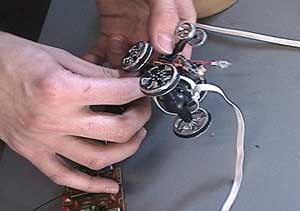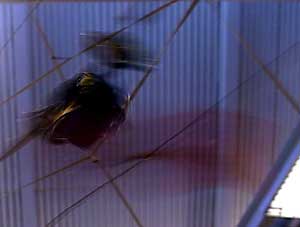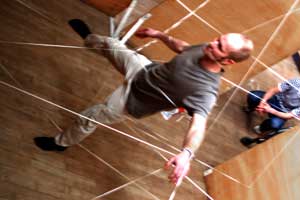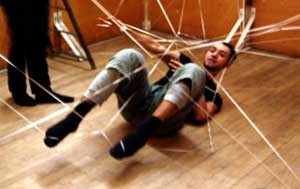Collaboration - Media Embodiment Workshop
2004 spring
School of Media technology
Royal Institute of Technology, Stockholm
Teachers
Marco Fonseca, Pablo Miranda, Adam Somlai-Fischer
www.arch.kth.se/mediaembodiment
BODY
Move your body, make a place
contents
1 Body movement in the production of space
An excursion along some of Lefevre's ideas about the primal link between body and space as well as through Laban's main theories on space, body movement and notation
2 Body language deconstruction and improvisation
A critical and comparative review of William Forsythe's works and improvisation techniques; and M. Cunningham's and John Cage's collaborative projects. in order to survey their different approaches to the relationship between body movement-space-time
3 Practical body workshop
A body movement improvisation-jamming, based on a given/found space and its derivates (light, matter, energy, sound, other bodies) in the production of a ‘tangible place' at the architecture school
1.Based on Henri Lefevre´s seminal work "the production of space"(1974)
2.Rudolph Laban was a Hungarian dancer, choreographer and thinker (1879-1958) highly involved in body movement analysis, notation and therapy investigation; and its relation to space
3.Supported by William Fortsythe´s CD Room "a tool for analytical dance eye"
4.Merce Cunningham is an American dancer and choreographer who worked for many years in collaboration with the American composer John Cage.
MACHINE
If media are, as Marshall McLuhan stated, the extensions of man, then new media in architecture demands a rethinking of the relation between the body and architectural space. This follows from the double nature of architecture both as result of media and technology and from its character as a medium itself.
Machine will deal with the space of interface between the body and the machine. This space is not only defined by the conventional categories such as solid and void, use or function. Its qualities stem from the complexities of feedback and the blurring of distinctions between the subject and the object in architectural space. The body gets extended in to the environment, the environment sips in to the body.
Concepts: information, control, communication, iteration, analogue.
Things that do their own thing
The make-up of our environments increasingly consists of the communication and control mechanisms embodied in diverse devices. From the binary logic of the photoelectric cells that open doors and fences, to the complex control algorithms of an elevator or the intricate communication protocols of cash machines, without forgetting, of course the absolute presence of cellular communication devices (namely, mobiles) that rule our daily experience of space, and have become in some cases even more relevant than the orthodox and traditional architectural categories such as light, tectonics, or metric space.
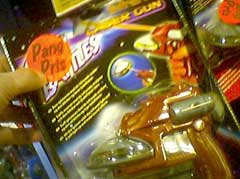
Spin Battles Laser Gun- IR sensor and sound
Despite the claims that our experiences are increasingly dominated by the disembodied immateriality of information (in the form of TV, Virtual Reality, Computer Games) we can also argue that our embodied experience of space is being transformed by the materialization of that same information.
Warren Chalk argued in an article which appeared in an AD in 1969, by the same title of this course, that children's interactive, reactive, autonomous toys would provide some of the clues on the materials architecture was (more than 30 years ago) increasingly made of.' …it looks as though an analogy can be drawn between toys and what is already happening in the environment'.
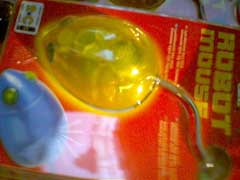
Robot Mouse- Sound triggered light and motion
"There is a place now for re-interpretations of what is important, what really matters in the environmental complexity that surrounds us. With man's boundary conditions breaking down and new directions and disciplines providing increased stimulus of interest, the static conventional know-how we called urbanism is being edged out by the try-it-and-see-it rethink"
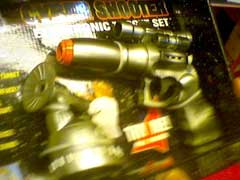
Cyber shooter, moving projection and IR sensors
We will explore the possibilities of such informational materiality. We will look at simple, ubiquitous devices that affect and form our daily experiential space. Toasters, switches or electronic toys, have infiltrated our environments, to the extend that they have become essential features of those environments. We will try to understand their functioning, as for example their relation to a body (theirs) and our own. We will develop a method of working that will take us away from the representational limitations of the drawing (traditional or implemented in a computer) and that will open the possibilities of tapping in to the operational capabilities of the devices. We will essentially try to tentatively propose another possible space: one that is not only made of the solidity of traditional architectural matter, but which is placed instead in the transition point of matter, information and energy.
PERFORMANCE
As a hybrid of Body and Machine, a choreographed performative space will be created as the result of the workshop. This should become a fluid architectural space, an event space where time and responsive physical and ephemeral bodies structure our experience.
When the participation of the user and author constantly renew the space, when improvisation and interaction blur, we might create an Open Source Architecture, a new concept debated at various today places, like ram4 and ram5.
In the last two days, we will take over a larger space at the school, adjust it to our needs and create such hybrid body, that will perform
Focus will be spatial appropriation, choreographed interaction. Various elements of this space will be developed together, some will be provided by us, like the dynamics of lights will be emphasized by fog created by a fog machine, microphones for amplified sounds, and perhaps a prepared piano.
Workshop results
IR Gaze
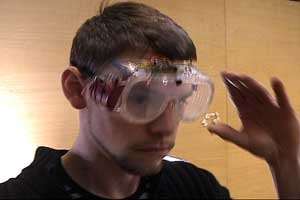
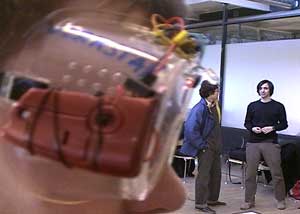
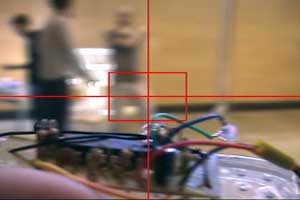
Grinder-Plotter

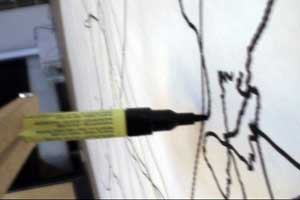
Sound Responsive Skeleton
